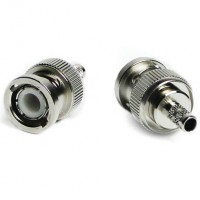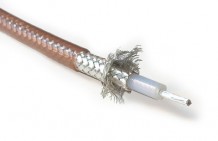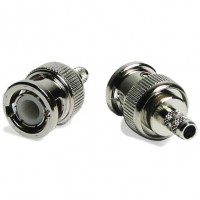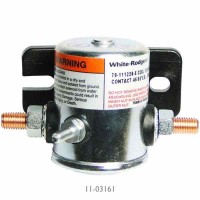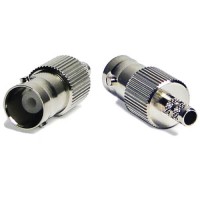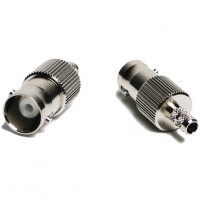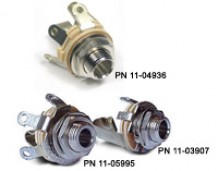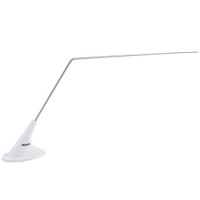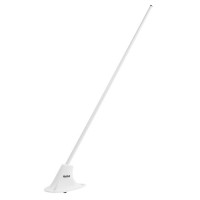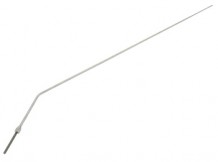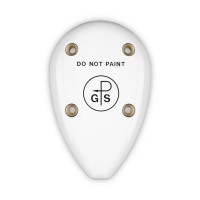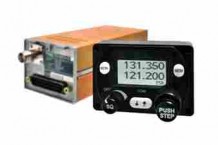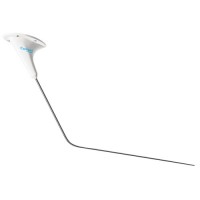VHF-5T Nav/COMMAntenna
Overview
|
Here is a new series of aircraft antennas specifically designed to be used without a ground plane. This means that composite aircraft and fabric covered aircraft can now have their antennas mounted totally within the structure. These antennas are designed using the latest engineering technology. Laboratory measurements show them to have better electrical characteristics than currently available products. The unanimous reports from pilots who have been using them confirm that they out perform everything now available on the market. One antenna model works for communication, navigation, and for ELT (Three antennas in the aircraft, but all the same design), and this design is tolerant to installation errors. They will work in metal airframes when a plastic or fiberglass wing tip or similar plastic component is available to provide the mounting structure. Model Differences: The VHF antennas, 5T and 5I, differ only in the location of the BNC connection. The 5T is configured to allow the coax cable to be routed flat along the mounting surface of the airframe. This antenna model would be appropriate for a composite aircraft where the antenna would be mounted in the fuselage or fin and the coax would be close to the skin and be attached periodically for strain relief. In either case, the antenna can be used as a retrofit on in service aircraft or in new installations. The 5I series has the BNC connection positioned so that the coax cable would route out and away from the antenna mounting surface. This configuration is offered for antenna installations such as wing tips of fabric aircraft. If the antenna is mounted on the inside of the tip, the coax route is directly inward toward the wing root and the BNC connection is located near the spar to provide support for the cable. Both antennas are identical in their electrical performance. |
WARNING: Cancer and Reproductive Harm - www.P65Warnings.ca.gov. |
Features
- Inside mounting.
- Use w/ composite skins.
- Use with fabric covered airframes.
- Glue or bond to the airframe. Light weight.
- Wide service temperature,
- No ground plane corrosion, Mount anywhere inside, Maximum range with low VSWR.
- Model VHF series designed for comm or nav or ELT (121.5 only)
- Guaranteed against failure for the life of the airframe.
- Adapts to existing airframes or to in process construction.
- Glue or bond to the airframe. Light weight. Wide service temperature, No ground plane corrosion, Mount anywhere inside, Maximum range with low VSWR. Model VHF series designed for comm or nav or ELT. Guaranteed against failure for the life of the airframe. Adapts to existing airframes or to in process construction.
FAQ
Q. What cable length is recommended for the antenna ?A. Any length can be used. This antenna is impedance matched to 50 ohms to allow you to use any length required.
Q. Can I use it in the plastic or fiberglass wingtip of a metal airplane ?
A. Yes, but the antenna must be as far from the metal wing as possible. We have had limited success with this. Not recommended for the RV series aircraft.
Q. Will the strobes cause interference ?
A. It is possible to couple the strobe audio squeal into the VHF radio. Thishappens when the antenna is close (about a foot) to the strobe.
Q. I thought the com antenna has to be vertical to work.
A. For maximum sensitivity, this is best. The VHF-5 antenna has a higher gainthan others but still when mounted in the horizontal plane the resultantsensitivity is reduced but useable.
Q. Can I mount the antenna on a metal part of my airframe?
A. No ! This antenna works best when separated from all large metal objects.Mounting it on any metal destroys its antenna properties.
Q. Some people have good operation with a ground plane working with their antenna, does this one do the same?
A. No, any ground plane will destroy the effectiveness of this antenna.
Q. My fabric airframe is completed, where is the best location for the antenna?
A. Mount it on a wood brace in the fuselage behind the cockpit. Fasten one end to a location on the lower part of the fuselage frame corner. Then fasten the other end to the opposite or diagonal part of the inside of the upper framecorner. Fasten the antenna to this installed piece of wood.
Q. Should I be careful of the angles at which I mount this wood?
A. No. As long as the antenna is in the same plane as the plane of rotation ofyour propeller, it'll work.
Q. What happens if I mount the antenna on one of my wood stringers on the fuselage?
A. The maximum range will always be off to the sides and the minimum range will be ahead and behind you.
Q. What happens if I mount the antenna on my wood spar in the wing?
A. The maximum range will always be ahead and behind you and the minimum range will off to the sides.
Q. What if the antenna has to be mounted with a bend to fit in the space I want to use?
A. Curving the antenna will fill in those minimum range areas mentioned above at the slight expense of the maximum range.
Q. Can't I have both?
A. No, only a fixed amount of energy can be radiated. If you redirect energy tofill in holes in the pattern you must remove some from one part of theradiation pattern to fill in the other.
Q. Why is it so long compared to others?
A. This is a dipole which is half wave length long and makes it about twice aslong as quarter wave antennas.
Q. Can this be made shorter ?
A. No, it must be used as manufactured. If it is cut to fit, it will be destroyed.
Q. Do I need a 337 ?
A. Perhaps. This is between you, your IA, and the local FAA. It mounts insideand so does not alter the airflow, it attaches with adhesive so no holes oralterations are required for the airframe mount, and it is too light weight toaffect weight and balance.
Q. Will this work on my canopy?
A. Yes, but keep it as far from the metal frame as practical.
Q. Why do I have to keep it away from metal things?
A. Any metal alters the characteristics of the tuning and pattern in unpredictable ways. Each airframe installation is different, so we recommend that you use tape and experiment with locations until you are satisfied with the operation.
Q. Where is a good location in my fiberglass fuselage?
A. Put the com antennas on either side in the tail cone, & if the fuselage isn'ttall enough bend the antennas to resemble the letter"C". If you are using two,stagger them on opposite sides and try to have about 24 inches or more in thestagger.
Q. Why haven't I seen this type of antenna previously?
A. This design has been in operation since 1981 but in response to consumer demand they are now being produced for the non-metal airframe market.
Diagram
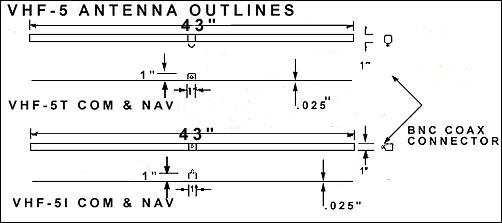
Reviews
Easily installed on the inside of my glass fuse and has excellent reception. Took longer for me to get into the back of the fuse than it took to install and get working. Cruise speed up by 3-4 knots without the external VHR antenna.
Avionics shop did a major upgrade on my Glasair III panel, but then neither new comm radio could work more than 6 miles. They didnt know what to do. Before they did the work, my prior comms worked long range. So I installed this antenna. Once I removed the Glasair interior, it took me ten minutes to install this antenna. Double sided tape works. Now like night and day. Both comm radios work just fine. Had to bend the top and bottom of the antenna to conform to the fuselage and that worked fine as well. Very satisfied. No one knew how to solve my problem, but this unit took care of the problem and was easy to install.
VHF-5T Nav/COMMAntenna
I did not want antennas on the outside of my WWI airplane so chose to put this on the inside. I haven’t completed the plane or installed the radios yet, but it looks like this is going to work very well.
Newly acquired gyroplane had extremely high radio SWR (15+), poor cable run and tiny ground plane. I had just heard about independent ground antennas and Aircraft Spruce had the best price. The antenna has very good documentation, the 2 wings are flexible composite, very easy to conform to the nosecone curve of the fiberglass tub. I used 4 pieces of 3M VHB double sided tape to mount, one under the center box (balun), and the others as needed. Very secure. The SWR is now ~1.1 at 123.000 and a max of 1.6 at 136.975. Great purchase.
Fit perfect in my aircraft and fixed the antenna mounting issue I had for my ELT.
Installed inside the aft fuselage of a Glasair 1TD. I previously had a standard Comm antenna with faux ground plane - lots of dead spots poor transciever performance. The VHF-5T solved ALL of those problems. Great reception, my transmissions are very clear and able to receive from any angle. GREAT antenna!
I installed the 5T comm antenna and the L2 transponder antenna inside the tail and fuselage during construction of my fiberglass Jabiru J230. My radio and Mode C transponder both work perfectly. Also, there are no ground planes to install and the antennas are hidden inside.
Q&A
Please note, Aircraft Spruce ®'s personnel are not certified aircraft mechanics and can only provide general support and ideas, which should not be relied upon or implemented in lieu of consulting an A&P or other qualified technician. Aircraft Spruce ® assumes no responsibility or liability for any issue or problem which may arise from any repair, modification or other work done from this knowledge base. Any product eligibility information provided here is based on general application guides and we recommend always referring to your specific aircraft parts manual, the parts manufacturer or consulting with a qualified mechanic.
The best route is to look at the FAQ tab on this page as the manufacture has answered a lot of these questions. This antenna is a non TSO'd. It is critical that it is mounted on a non metal surface.
The Advanced antenna series are BNC female out. You will need a male BNC connector for this antenna.
Yes, this antenna will work through wood & fabric and composite aircraft like carbon fiber.
Per the manufacture, this antenna is designed for wood & fabric and composite aircraft like carbon fiber. Please refer to the FAQ tab on our page for more info on mounting.
The Advanced Aircraft Electronics High gain antenna was designed to be used with the 121.5 ELT frequency only.
Yes, the Advanced Aircraft Electronics High Gain Antenna will work through in a tube & fabric plane.
As of 3/2015, no there is not currently a TSO'd version of this antenna.
The Advanced Aircraft VHF-5 antenna has a vswr of 1.6 nominal and 1.9 maximum.
It should be installed vertically in the fuselage. Please consult the FAQ tab for more information.
Per the Manufacturer the gain is 2db.


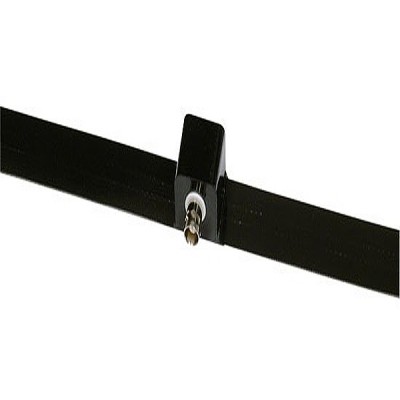





 FREE Shipping
FREE Shipping

